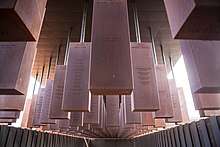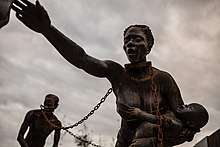The National Memorial for Peace and Justice
 The memorial includes 805 hanging steel rectangles, representing each of the counties in the United States where a documented lynching took place | |
| Established | April 26, 2018 |
|---|---|
| Location | Montgomery, Alabama |
| Coordinates | Coordinates: 32°22′18″N 86°18′46″W / 32.37175°N 86.31284°W |
| Founder | Equal Justice Initiative |
| Website | Official website |
The National Memorial for Peace and Justice, informally known as the National Lynching Memorial,[1] is a national memorial to commemorate the victims of lynching in the United States in order to acknowledge the past of racial terrorism in the search for social justice. Founded by the Equal Justice Initiative, it opened in downtown Montgomery, Alabama on April 26, 2018.[2][3]
Background
The memorial was built on six acres in the downtown area of the state capital by the Equal Justice Initiative (EJI), a non-profit based in Montgomery. Also under the auspices of EJI is The Legacy Museum: From Enslavement to Mass Incarceration. It is built near the Montgomery site where enslaved African Americans were auctioned at market.[4] The development and construction of the memorial complex cost an estimated $20 million raised from private foundations.[5] The EJI's founder, Bryan Stevenson, was inspired by the Memorial to the Murdered Jews of Europe in Berlin, Germany, and the Apartheid Museum in Johannesburg, South Africa, to create a single memorial to victims of white supremacy in the United States.[6]
By studying records in counties across the United States, researchers documented almost 4400 "racial terror lynchings" between 1877 and 1950.[7][6][8] An error with the name of a victim from Duluth, Minnesota, was corrected. The mistake, according to Kiara Boone, deputy program manager for EJI, evidences both error and fabrications in contemporary newspaper reports: "Oftentimes the mainstream press's coverage of these lynching events was something that would not hold up to journalistic integrity by today's standards".[9]
Description
In central position is the memorial square with 805 hanging steel rectangles, the size and shape of coffins, representing each of the counties in the United States where a documented lynching took place, as compiled in the EJI study, Lynching in America: Confronting the Legacy of Racial Terror (2017, 3rd edition). There were more than 4300 documented lynchings of African Americans between 1877 and 1950 concentrated in 12 southern states, but several other states are now covered. The monument is the first major work in the nation to name and honor these victims.[10]. Each of the steel plates is marked with the names of the documented lynching victims.
The central memorial was designed by MASS Design Group[11] from Boston with Lam Partners lighting design,[4] and has been built on six acres purchased by EJI.[2][12] Artwork in the museum includes a sculpture on slavery by Ghanaian artist Kwame Akoto-Bamfo, at the beginning; a sculpture "dedicated to the women who sustained the Montgomery Bus Boycott" by Dana King to help illustrate the Civil Rights period; and a piece about today's police violence and the biased criminal justice system, by Hank Willis Thomas.[11]
In Hank Willis Thomas' piece, Rise Up, the focal point is a wall, and emerging from the wall are statues of black heads and bodies raising their arms in surrender to the viewer. The piece brings up the notion of visibility, which is the aim of the entire monument. The viewer is asked to focus and see the subject of the artwork. This is a more current piece[13] commenting on the police violence and police brutality prevalent in the years preceding the memorial. Hank Willis Thomas says in an interview[14] about his art work, “I see the work that I make as asking questions.”
Outside of the structure, in the surrounding landscaped area, are benches where visitors can sit to reflect. Reflecting areas are dedicated to honor and memorialize people such as Ida B. Wells, who in the 1890s risked her life to report on the truth about lynchings.[15] Laid in rows are corresponding steel columns identical to the ones hanging in the Memorial. These columns are intended to be temporary, and the Equal Justice Initiative is asking representatives of each of the counties to come and claim their monument and establish a memorial on home ground.[16] A month after the opening the Montgomery Advertiser reported that Montgomery County, after receiving a petition from citizens, was considering asking for their column; both the county and the city of Montgomery had already been discussing this.[17]
Importance for Montgomery, tourism
Prior to the 1990s little attention was paid in Montgomery to the painful legacy of slavery and racism, though the city is now marketing a Civil Rights trail and the buildings and locations associated with slavery,[18] and the city became a New York Times Top 2018 Destination.[19] Lee Sentell of the Alabama Department of Tourism acknowledged that the National Memorial offers a different and painful encounter: "Most museums are somewhat objective and benign...This one is not. This is aggressive, political. ... It's a part of American history that has never been addressed as much in your face as this story is being told".[18] Mayor Todd Strange suggested that the memorial offered "our nation's best chance at reconciliation".[20]
The opening celebrations, in May 2018, drew thousands of people to Montgomery,[20] perhaps as many as 10,000. Artists that performed included Stevie Wonder, Patti LaBelle, and Usher; speakers included John Lewis.
The memorial and its attendant museum are expected to provide Montgomery with a great boost in tourism,[21] even if it is dark tourism.[19] The Atlanta Journal-Constitution noted that with the addition of the memorial and the museum Montgomery and Atlanta together provide a narrative of African-American history.[21] Tourism officials said that possibly 100,000 extra visitors per year,[22] though the infrastructure of Montgomery and Alabama might not provide easy access to the city.[23]
The Legacy Museum
.jpg)
Opened on the same date as the outdoor memorial, The Legacy Museum: From Enslavement to Mass Incarceration is a museum that displays and dramatizes the history of slavery and racism in America. The progress through the museum is chronological, beginning with slavery, and progressing through the heyday of lynching, the Civil Rights era, and the present.[11] This includes the enslavement of African-Americans, racial lynchings, segregation, and racial bias. The memorial complex features artwork by Hank Willis Thomas, Glenn Ligon, Jacob Lawrence, Elizabeth Catlett, Titus Kaphar, and Sanford Biggers. One of its displays is a collection of soil from lynching sites across the United States.[5] This exhibit stands to show the vast impact of slavery, lynching, and black oppression across state lines. The exhibits in the 11,000-square-foot museum include oral history, archival materials, and interactive technology.[24]
Gallery
 Outside view of the memorial
Outside view of the memorial Installation by Kwame Akoto-Bamfo
Installation by Kwame Akoto-Bamfo Memorial Monuments
Memorial Monuments Installation by Hank Willis Thomas
Installation by Hank Willis Thomas Steel columns intended for each county
Steel columns intended for each county
See also
- List of museums focused on African Americans
- List of lynching victims in the United States
- Topography of Terror: museum in Berlin, Germany dedicated to the victims of the Nazi regime
- National Museum of African American History and Culture
References
- ↑ Capehart, Jonathan (21 December 2016). "What the lynching memorial will force us all to face". The Washington Post. Retrieved 15 January 2017.
- 1 2 The Memorial for Peace and Justice
- ↑ Campbell Robertson (25 Apr 2018). "A Lynching Memorial Is Opening. The Country Has Never Seen Anything Like It". New York Times.
- 1 2 Edgemon, Erin (16 August 2016). "Nation's first memorial to lynching victims, museum set for Montgomery". The Birmingham News. Retrieved 23 August 2016.
- 1 2 Miller, James H. (April 16, 2018). "Alabama memorial confronts America's racist history". The Art Newspaper. Retrieved April 20, 2018.
- 1 2 Robertson, Campbell (2018-04-25). "A Lynching Memorial Is Opening. The Country Has Never Seen Anything Like It". The New York Times. Retrieved 2018-04-26.
- ↑ Robertson, Campbell (2015-02-10). "History of Lynchings in the South Documents Nearly 4,000 Names". The New York Times. ISSN 0362-4331. Retrieved 2018-04-26.
- ↑ "Equal Justice Initiative's report". Equal Justice Initiative's report. Retrieved 2018-04-26.
- ↑ Weber, Tom (June 5, 2018). "National lynching memorial: A jarring, but understandable error to remember Duluth victim". Minnesota Public Radio. Retrieved June 8, 2018.
- ↑ Song, Jean (16 August 2016). "Alabama lynching memorial aims to confront ramifications of slavery". CBS News. Retrieved 23 August 2016.
- 1 2 3 Wright, Barnett (April 19, 2018). "What's inside Montgomery's national peace and slave memorial museum opening April 26". Birmingham Times. Retrieved April 21, 2018.
- ↑ "EJI Announces Plans to Build Museum and National Lynching Memorial". Equal Justice Initiative. August 16, 2016. Retrieved 23 August 2016.
- ↑ "A New National Memorial To Victims Of Lynching - 1A". 1A. Retrieved 2018-05-02.
- ↑ "Artist Spotlight: Hank Willis Thomas, United States". www.imodara.com. Retrieved 2018-05-02.
- ↑ "Ida B. Wells: Lynching museum, memorial honors woman who fought lynching". The Washington Post. Retrieved 2018-04-27.
- ↑ Henderson, Nia-Malika (April 9, 2018). "This new lynching memorial rewrites American history". CNN. Retrieved April 12, 2018.
- ↑ Edwards, Brian (May 23, 2018). "Montgomery County in talks to accept EJI monument". Montgomery Advertiser. pp. 1, 6A.
- 1 2 Elliott, Debbie (April 26, 2018). "New Lynching Memorial Is A Space 'To Talk About All Of That Anguish'". NPR. Retrieved June 8, 2018.
- 1 2 Baxter, Tom (June 4, 2018). "Dark Tourism: The world comes to Montgomery". Saporta Report. Retrieved June 8, 2018.
- 1 2 "Montgomery: 'Where past, present and future intertwine'". Montgomery Advertiser. May 31, 2018. Retrieved June 8, 2018.
- 1 2 "Heading to Montgomery? Make time for Atlanta's King sites". The Atlanta Journal-Constitution. May 16, 2018. Retrieved June 8, 2018.
- ↑ Riales, Bill (May 17, 2018). WKRG http://www.wkrg.com/news/state-regional/lynching-museum-could-boost-tourism/1184537119. Retrieved June 8, 2018. Missing or empty
|title=(help) - ↑ "Lynching memorial could turn Montgomery into tourist hot spot". The Birmingham News. May 16, 2018. Retrieved June 8, 2018.
- ↑ Dafoe, Taylor (April 26, 2018). "A Look Inside the New Alabama Museum and Memorial Boldly Confronting Slavery and Its Brutal Legacy". Artnet. Retrieved April 26, 2018.
External links
| Wikimedia Commons has media related to Memorial for Peace and Justice. |